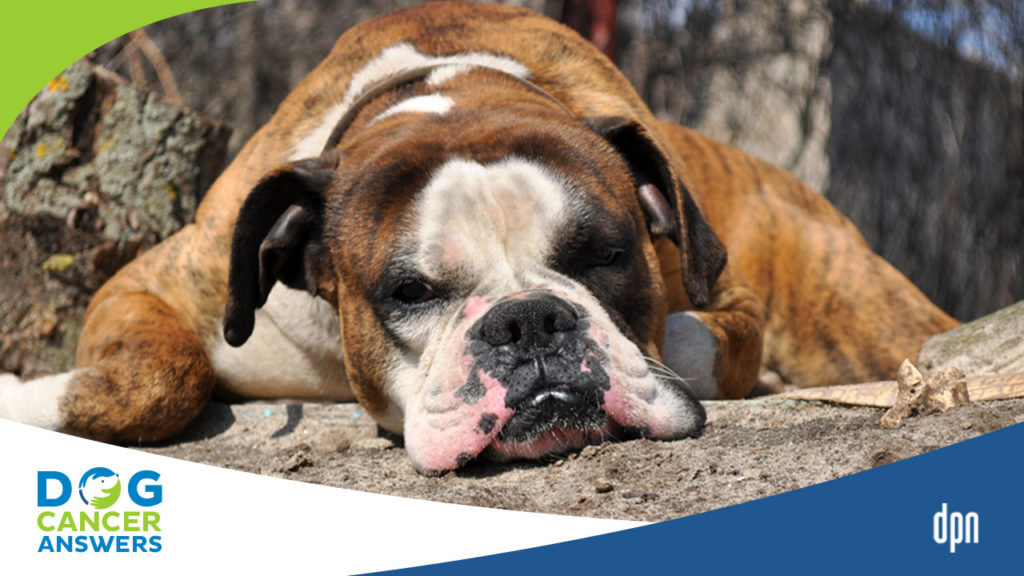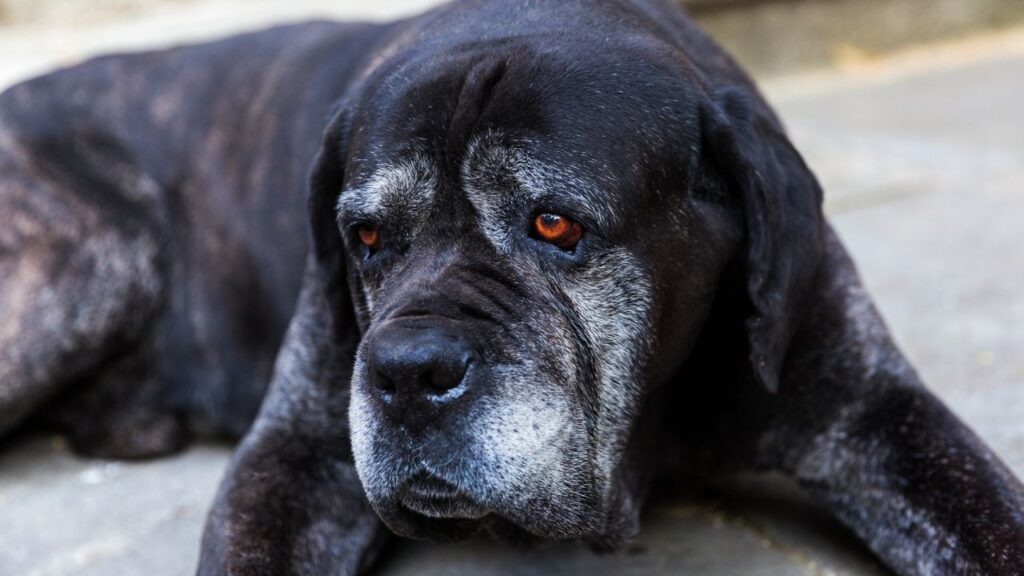Bladder Cancer in Dogs, Including Transitional Cell Carcinoma
With new technology for early detection and multiple treatment options available, most dogs diagnosed with bladder cancer, including transitional cell carcinoma, can expect good quality of life for up to two years.
Key Takeaways
- The most common signs of bladder cancer in dogs are related to urination: urinating small amounts frequently, urinating blood, straining to urinate, or making multiple unsuccessful attempts to urinate.
- The late stages of bladder cancer bring increased difficulties with urination as the cancer grows and obstructs the urinary tract. If it has metastasized to other organs like the liver, lungs, or bones, symptoms related to those organs may also occur.
- Dogs with bladder cancer can experience discomfort, particularly when the urine is obstructed. If you have ever had a urinary tract infection or any type of problem in the urinary tract, you will be familiar with this type of discomfort.
- Most dogs diagnosed with bladder cancer are between 9 and 11 years old.
- In the early stages of bladder cancer, dogs show no signs at all. The first symptom that something is wrong is when the tumor gets large enough to block or obstruct the urinary tract, and you see your dog having urinary trouble.
- It’s common for dogs with bladder cancer to also have a UTI, and dogs are often treated for a UTI prior to finding bladder cancer.
- Because bladder cancer is often found late, how much time you have left varies widely. Left untreated, most dogs live with bladder cancers, including transitional cell carcinomas, for months, not years.
- Treatments for bladder cancer focus on arresting tumor growth and relieving obstructions so that dogs can urinate comfortably and have a good quality of life. There are several good medications to accomplish this.
Most Bladder Cancers in Dogs are Transitional Cell Carcinoma
There are multiple types of bladder cancer in dogs, but all of them have the same effects on the body. Transitional cell carcinoma in dogs (also called TCC) is the most common tumor type in the bladder.
Transitional cell carcinomas are also sometimes called urothelial carcinomas (UC).
TCC tumors account for 50-75% of all bladder cancers. They most commonly grow from the lining of the bladder wall but can also be found in the prostate, kidneys, ureters, and urethra.
Other Types of Bladder Cancer in Dogs
Other types of tumors found in the bladder include:1
- Squamous cell carcinomas (SCC)
- Undifferentiated carcinomas
- Adenocarcinomas
- Papillomas
- Fibromas
- Fibrosarcomas
- Leiomyosarcomas
- Botyroid rhabdomyosarcomas
What Happens with Bladder Cancers, Including TCC
Left untreated, any of these types of bladder cancers can obstruct urine flow from the kidneys to the bladder or from the bladder to the outside of the body.
This obstruction causes difficulty in urination, and if it progresses to complete obstruction, a life-threatening blockage.
All of these bladder cancer tumor types can also spread to the lymph nodes and other body organs, including the lungs and liver.
Bladder Cancer and Transitional Cell Carcinoma (TCC) Stats and Facts
- About 2% of all cancers in dogs are transitional cell carcinoma (TCC).
- Most TCC tumors are intermediate to high-grade papillary (long and fingerlike) infiltrative (invading surrounding normal tissue) tumors. This means they are aggressive and have long fingers, making them hard to remove by surgery.
- There is also a low-grade form of TCC, but unfortunately, it is uncommon.2
- The average age of a dog at the time of bladder cancer diagnosis is 9-11 years.2
- Dog lovers often bring their dogs in for urinary tract infections (UTIs), and about 55% of dogs will have a positive urine culture at some point during their diagnosis or treatment.3
- Many diagnoses are made only after treatment for a urinary tract infection fails to help, or UTIs recur, leading veterinarians to look for another cause for the symptoms.
- Approximately 20% of dogs diagnosed with TCC/UC will have evidence that the tumor has already spread to other body parts at the time of diagnosis. This is associated with a worse prognosis.4
- Bladder cancer can spread to many parts of the body, including the lymph nodes, liver, and lungs. Bladder cancer metastasis can also be found in the bone and other organs.4
What Causes Bladder Cancer in Dogs
The exact cause of bladder cancer in dogs is not known. Like all cancers in dogs, it is a multifactorial disease, and many things must go wrong for cancer to take hold and progress.
However, we think there is a genetic predisposing factor since it is found more commonly in certain breeds.
Environmental factors can also predispose dogs to bladder cancer, such as chemical or toxin exposure.4
Risk Factors for Bladder Cancer
Certain breeds are more likely to be affected by bladder cancer.2,4
- The Scottish Terrier has 18-20 times increased risk for TCC/UC.
- Other breeds at higher risk include Airedale Terriers, Shetland Sheepdogs, Beagles, West Highland White Terriers, Wire Haired Fox Terriers, and Eskimo dogs.
Gender and reproductive status may also play a role in the development of bladder cancer. Female dogs are more likely to develop this cancer, for example, and it is more commonly seen in spayed and neutered dogs than in intact dogs.
Exposure to certain chemicals is linked with many cancer types, including bladder cancers.
A link between cigarette smoke and bladder tumors in humans has been investigated. However, this has not been proven in dogs at this time.5
Other chemicals of concern include herbicides and pesticides. Dogs exposed to treated lawns and older flea dips are more likely to develop TCC/UC.2,4 (The flea dips reviewed contained petroleum distillates, aromatic petroleum solvents, polyethers, and/or xylene. These chemicals were not confirmed to cause TCC/UC, but were common to the products reviewed in the study.)
Dr. Lauren Trepanier is proving the links between pollution and bladder cancer. Learn more in this episode of DOG CANCER ANSWERS.
Symptoms of Bladder Cancer in Dogs
Most symptoms associated with bladder tumors involve difficulty in urinating. Many of these symptoms can easily be mistaken for urinary tract infections and include:
- Urinating small amounts frequently
- Urinating blood
- Straining to urinate or making multiple attempts to urinate
The most common cause of these problems is a urinary tract infection, so dogs are often treated for that first, and then only later for bladder cancer. As noted above, over half the dogs with bladder cancer will also have a UTI during their diagnosis or treatment.
If the tumor spreads to the bones, pain or lameness is a less common bladder cancer symptom.
Uncommonly, dogs may develop a condition called hypertrophic osteopathy, which causes bone pain.
Your dog’s veterinarian should address any of these symptoms.6
Diagnosing Bladder Cancer and TCC in Dogs
Unfortunately, for dogs with bladder cancer, diagnosis is usually delayed because:
- There is no outward indication or sign that bladder cancer is forming and growing until it’s large enough to cause the dog urinary discomfort.
- Their symptoms of urinary discomfort are often initially mistaken for multiple other conditions that are more common than bladder cancer (recall that only 2% of all cancers in dogs are TCC).
For this reason, it is recommended to be proactive about monitoring middle-aged dogs with a higher risk of TCC before symptoms are seen. If your veterinarian wants to do a urinalysis and/or ultrasound alongside routine bloodwork for your middle-aged dog’s wellness check, it could be partly to try to catch a bladder or other type of cancer early. (Also see the CADET BRAF test, below.)
Urinalysis
The process of diagnosis starts with a urinalysis. Urinalysis is a low-sensitivity test for bladder tumors, meaning false negatives are highly likely. However, it still may show abnormal cells that indicate a bladder tumor, so it is worth doing.
Ultrasound
Abdominal ultrasound is more helpful. This non-invasive, safe imaging technique will allow a skilled veterinarian or radiologist to see evidence of a mass in the bladder, kidneys, ureter, prostate, and a portion of the urethra.
Unfortunately, you cannot see all parts of the urethra on ultrasound, so some TCC/UCs may be missed if they are in a portion of the urinary tract that cannot be seen.
An ultrasound can also be a helpful part of the staging process (as discussed below).
Fine Needle Aspirate Is Usually Not Recommended for Bladder Cancer
In other cancers, when a mass is found during an ultrasound, a needle can be used to aspirate cells from the mass to aid in diagnosis.
However, your veterinarian probably will not offer you this diagnostic test, because it is not recommended for bladder cancer, as the needle may pull cancer cells through the abdomen and spread cancer.4
Cystoscopy
A cystoscopy may also be performed. In this procedure, a fiberoptic scope is inserted into the urethra and maneuvered into the bladder. The veterinarian can see what is happening inside the length of the urinary tract and even collect a tissue biopsy.
As with all cancers, a biopsy is the gold standard method of diagnosis; however, a veterinary hospital must have the proper equipment and training to perform this procedure, so cystoscopy is typically only done in specialty hospitals.4
Do not worry if you can’t get your dog’s tumor biopsied; your veterinarian can still diagnose and treat bladder cancer, as you will see below.
CADET BRAF Mutation Detection Assay
More recently, a new test, the CADET BRAF Mutation Detection Assay, is being used to detect TCC/UCs. This test looks for a mutation in the BRAF gene found in 85% of TCCs. It is very helpful because it is non-invasive and may be able to find TCC/UCs missed on ultrasound.
This mutation is not present in inflammation, polyps, or other kinds of bladder tumors, so while CADET BRAF helps identify transitional cell carcinoma in dogs, it may miss other types of cancers in the urinary tract.2,7
To get the test, veterinary staff or pet parents collect a urine sample and submit it to the lab for testing in a special container with a preservative.
Dr. Nancy Reese talks about the new CADET BRAF urine test that can help detect transitional cell carcinoma early in this episode of DOG CANCER ANSWERS.
Prognosis and Staging for Bladder Cancer and Transitional Cell Carcinoma in Dogs
Staging bladder cancer in dogs involves finding out precisely where the tumor is located and if it has spread to other body parts.
For bladder tumors, the recommended staging tests include:
- A full physical exam (including a rectal exam)
- Blood chemistry
- Complete blood cell count (CBC)
- Urinalysis
- Chest X-rays
- Abdominal ultrasound
- Urine culture
A CT scan and lymph node aspirates may also be recommended depending on the results of the other tests.
The Prognosis for Bladder Cancer
Once you have staged your dog’s bladder cancer, your veterinarian or oncologist will be able to give you some information about their prognosis.
The prognosis depends upon the following:2,6
- The location of the tumor
- If it is invading the urethra or other surrounding tissues
- If it is causing obstruction of the urinary tract
- How quickly the tumor is growing
- The specific diagnosis of the tumor type.
Without any form of treatment, dogs with bladder cancer, including transitional cell carcinoma, usually die from complications within a few to several months. How long this takes depends on how far along the cancer is when it is diagnosed, and how quickly it grows.
The prognosis improves with treatment:
- Treating with non-steroidal anti-inflammatory drugs (NSAIDs) has an average survival time of approximately six months.8
- Combining NSAIDs with chemotherapy has an average survival time of 10-11 months.8
- Combining NSAIDS with chemotherapy and radiation therapy has an average survival time of 20 months.8
Treatment for Bladder Cancer in Dogs, Including Transitional Cell Carcinoma
When treating cancer in dogs, we usually do not aim for a “cure.” Instead, the focus is improving and maintaining your dog’s quality of life and hopefully extending life beyond what would happen if the cancer wasn’t treated.
The treatment goal for bladder cancer is to control or shrink cancer to relieve urinary difficulties, and to provide good life quality for as long as possible.
Unfortunately, the treatments for bladder cancer in dogs buy good quality time but are rarely totally curative.6
Surgery for Bladder Cancer
Not all bladder cancers are candidates for surgery, because this area of the body is delicate and complex, and so many bladder cancers infiltrate surrounding tissues with long, thin fingers (recall that most of these cancers are intermediate to high-grade papillary infiltrative tumors).
Surgical removal of the tumor may be possible if the tumor is in the apex (the top portion) of the bladder.
Imagine the bladder as a balloon. The tied end of the balloon at the bottom is the sphincter, the little ring of muscle that closes off the bladder until it’s time to pee. The apex will be at the top of the balloon, away from vital structures like sphincters and ureters, and the urethra.
If the tumor is in the apex, it may be safe for your veterinarian to remove or biopsy it.
Removing or biopsying the tumor may be impossible if it is lower down, near the other structures at the bottom of the balloon.
If it’s possible to perform surgery, it can be helpful to get a good mass sample for further testing, like histopathology.
Surgery may also restore proper urine flow in dogs with urinary difficulties, depending upon the case.
However, even when surgery is possible, removing the entire tumor is often impossible, and bladder tumor regrowth is common.1,4
Dr. Brooke Britton discusses why surgery is so hard to do with bladder cancers in this episode of DOG CANCER ANSWERS.
Surgical Stent
Another surgical option is stent placement. A stent can be placed to reduce urinary obstruction, and possibly prolong survival time.
Because stents don’t remove the tumor, this is more of a palliative (comfort care) option. The stent props open the urinary tract slightly so urine can pass more easily.
Median survival time after stent placement is 78 days, ranging from 2 to 366 days.9,10
Cystostomy
Lastly, a cystostomy tube can be placed surgically. This tube allows urine to drain from the bladder directly to the outside of the abdomen. This allows a dog with a urinary obstruction to pass urine through the tube, rather than through the obstructed urinary tract.
Cystostomy is also considered a palliative measure because it does not treat the tumor, but provides relief.
If this is an option for your dog, you will get instructions about the special care needed to prevent infection. You must empty the bladder through the tube multiple times per day.4
Chemotherapy
Many chemotherapy options are available for treating bladder cancers in dogs. The most used drugs are piroxicam, mitoxantrone, and vinblastine.
- Piroxicam is not usually called chemotherapy, because it is a non-steroidal anti-inflammatory drug (NSAID). However, piroxicam has been shown to decrease the tumor size in 12 out of 18 dogs in a study,11 so it is often prescribed for transitional cell carcinoma or other bladder cancers. The median survival time for dogs treated with piroxicam alone is 6 months.8
- Mitoxantrone is an intravenous chemotherapy drug that is one of the most recommended treatments for dogs with bladder cancer. Remission was seen in approximately 35% of patients when combined with piroxicam. The average survival time for dogs treated with mitoxantrone and piroxicam was 291 days.12
- Vinblastine is an intravenous chemotherapy drug. It results in partial remission in 35% of dogs and stable disease (the size of the tumor is controlled, but the tumor does not shrink) in 50% of dogs.13 When used simultaneously with piroxicam, the median survival time is 299 days.14 One study found that if dogs are treated with intravenous vinblastine followed by piroxicam, the median survival time increased to 531 days.14
- Doxorubicin is an intravenous chemotherapy drug that has been shown to be effective in treating multiple cancers in dogs. Combined with piroxicam, it has been found to give a median survival time of 168 days.15
When treatment is started, follow-up visits will be used to determine if the cancer is responding to the treatment. (As with all cancers in dogs, “responding” means everything from the tumor is no longer growing, to growing slowly, to shrinking in size.)
If there are signs that the tumor is no longer growing or shrinking, the treatment course will be extended. If there are signs that the tumor is continuing to grow, the medications can be changed based on guidance from a veterinary oncologist.
Metronomic Chemotherapy
Metronomic chemotherapy involves giving a low dose of an oral chemotherapy drug called chlorambucil (also known as Leukeran).
Metronomic chemotherapy aims to interfere with the tumor’s ability to grow blood vessels, starving it of nutrition. This treatment can control the cancer (keep it from growing) in 70% of patients.
This treatment is well tolerated with minimal side effects, and the median survival time was seven months.4
Radiation
Radiation therapy is commonly recommended to treat bladder and other urinary tract tumors. Combined with chemotherapy and NSAIDs, it gives the best long-term prognosis.
It does, however, come with possible harmful complications, including scarring and shrinking of the bladder and possible damage to surrounding organs.6
Radiation is typically given as five treatments per week for four weeks.8 This must be done in a specialty hospital with specialized equipment for radiation therapy.
Immunotherapy Options for Bladder Cancer
There are some promising new treatments for bladder cancer in dogs using immunotherapy.
OncoTherad Intravesical Immunotherapy
One new treatment option currently undergoing further study is OncoTherad intravesical immunotherapy.
This is a nanostructured compound infused into the bladder of dogs with bladder cancer. It has anti-cancer properties and has been shown to decrease tumor volume by approximately 62% after six treatments and by 84% after 24 treatments.
While this treatment is not widely available currently, it is something to consider looking forward to in the future.16
Photoimmunotherapy
Another promising new treatment undergoing further research is photoimmunotherapy. This highly selective treatment uses a monoclonal antibody (mAb) that binds to bladder cancer cells. Then infrared light is used to damage the cells bound by the antibody.
Studies have shown that this treatment can significantly inhibit tumor growth and does not carry the same systemic side effects as chemotherapy. It is not currently in widespread use.17
Immunotherapy to Block Regulatory T-Cells (Treg)
Currently under investigation for treating multiple tumor types in humans and dogs is immunotherapy to block regulatory T-cells (Treg). It has been found that tumors infiltrated by Treg, a type of white blood cell, are likely to have a worse prognosis.
Dogs with bladder cancer receiving immunotherapy using intravenous infusions of mogamulizumab and treatments with piroxicam were studied against a control group of dogs receiving piroxicam alone.
The study found that adding the immunotherapy significantly increased progression-free and overall survival times. It was very safe, with only mild side effects reported (vomiting, diarrhea, rash, infusion-related reaction).18
Vaccine
Clinical trials are underway for a vaccine that would target the BRAF V595E protein (the canine equivalent of the BRAF V600E protein in humans) to be used as part of treatment for bladder cancers in dogs. However, this is still in the very early stages.
Hopefully, with further research, this will add to the existing treatment options available for dogs with bladder cancer.19
Diet
The most significant amount of evidence for diet’s relationship with bladder cancer has been seen in Scottish Terriers. It was found that dogs who eat vegetables (especially green leafy vegetables and yellow-orange vegetables) at least three times per week have less risk of developing TCC.20
Some examples of leafy greens and yellow-orange vegetables safe for dogs include:
- Lettuce
- Spinach
- Chard
- Cabbage
- Kale
- Carrots
- Yams
- Pumpkin
Supplements
There are a variety of supplements that may be beneficial for general health support in cancer patients.
One that may be helpful specifically for bladder cancer is sulforaphane, an isothiocyanate derived from cruciferous vegetables like broccoli. Studies in humans have shown that sulforaphane is well-tolerated with virtually no side effects and inhibits bladder cancer.22
A 2018 study in healthy dogs showed that dogs successfully absorb sulforaphane when given by mouth,23 so it may be worth asking your veterinarian about starting a sulforaphane supplement. Feeding your dog broccoli may also be something to ask about.
Researchers at The Ohio State University, North Carolina State University, and the University of Missouri began a clinical trial in the fall of 2022 to determine whether probiotics improve the outcomes for dogs with TCC undergoing chemotherapy. Probiotics are safe and can easily be added to your dog’s treatment plan as we await the trial results.
Integrative Therapies
There are currently no studies to support the use of integrative therapy specifically for bladder cancer in dogs. However, there is information on an integrative approach for humans, which may be helpful.
- Drinking non-chlorinated water and having the water tested for arsenic is recommended.
- All smoking and second-hand smoke exposure should be avoided.
- Diets should have high amounts of vegetables, while refined carbohydrates should be avoided.
- Live-culture yogurts and probiotics are recommended, with Lactobacillus casei and Lactobacillus rhamnosus being the most well-studied (a minimum of 5 billion live organisms daily is recommended).21
Vitamin E (with caution)
Vitamin E supplementation was found to be protective against bladder cancer in a large, prospective cohort trial in people,21 however, other studies have found high doses to be unsafe. Vitamin E is fat-soluble and it can build up in your dog’s fat stores over time. Because of this safety concern, vitamin E should never be given as a supplement without guidance from your veterinarian about your dog’s specific needs for this vitamin.
Immune Boosting Supplements, Including Medicinal Mushrooms
Immunomodulating supplements such as Grifola umbellata (zhuling mushroom), Grifola frondosa (maitake mushroom), Trametes versicolor (Turkey tail mushroom, yun zhi, cloud mushroom), Panax ginseng (Asian ginseng) root, Eleutherococcus senticosus (eleuthero) root, and Lentinula edodes (shiitake mushroom) may be helpful. They should be considered synergystic, meaning they work best together.21
Vitamin D (with Caution)
Vitamin D may help reduce the malignancy of TCC and induce apoptosis (programmed cell death) in cancer cells. But this should be used only with regular blood work and medical monitoring, as high doses of Vitamin D are toxic.21
The End Stages of Bladder Cancer and Transitional Cell Carcinoma (TCC)
The most common problem facing dogs with late-stage bladder cancer is the obstruction of urine flow as the tumor grows.
Just like it does in people, this can make urination uncomfortable, and dogs may strain to urinate or urinate blood. If you have ever had a urinary tract infection or obstruction, you understand what this feels like for your dog.
A complete obstruction that fully blocks the urethra is an emergency that requires immediate veterinary intervention. An untreated urinary obstruction will be fatal.
Other late stage symptoms may also appear. Breathing difficulty may be seen if the tumor has spread to the lungs. Nausea, vomiting, and inappetence (not wanting to eat) can be seen if the tumor spreads to the liver.
Limping or discomfort can be seen if the cancer spreads to the bone.
There is also a paraneoplastic syndrome called hypertrophic osteopathy that can be seen in some bladder cancer patients. This causes the bones of the legs to be painful.
Euthanasia Considerations
Urinary difficulties and pain may increase at the end if tumors can no longer be controlled. Your veterinarian may bring up hospice and possibly humane euthanasia if they feel they can no longer help your dog with urination or a change in pain medications.
If you are worried about your dog’s suffering at any point, do not hesitate to bring up euthanasia with your veterinarian proactively. They will help you to understand your dog’s discomfort and pain levels and help orient you to how close you may be to the end stages of bladder cancer.
Prevention Strategies for Bladder Cancer in Dogs
While there is no way to completely prevent your dog from developing bladder cancer, there are some things you can do to minimize risk:
- Prevent exposure to smoking
- Don’t use lawn herbicides
- Avoid “old generation” flea medications and dips
- Include green leafy vegetables and yellow-orange vegetables in the diet
- Give probiotics
- Be a vigilant pet parent if you have a dog breed predisposed to bladder cancer, particularly middle-aged or older. If recurrent UTIs are seen, look into further diagnostics like ultrasound and BRAF testing.
- Knapp D, McMillan S. Tumors of the urinary system In: Withrow, Vail, Page, eds. Withrow & MacEwen’s Small Animal Clinical Oncology. 5th ed. St. Louis, MO; Elsevier Saunders; 2013:572- 582.
- Ackley D. A new approach to diagnosing transitional cell carcinoma in dogs. MSPCA Angell. https://www.mspca.org/angell_services/transitional-cell-carcinoma-in-dogs/. Accessed November 30, 2022.
- Budreckis DM, Byrne BA, Pollard RE, Rebhun RB, Rodriguez CO Jr, Skorupski KA. Bacterial urinary tract infections associated with transitional cell carcinoma in dogs. J Vet Intern Med. 2015;29(3):828-833. doi:10.1111/jvim.12578
- Knapp D. Penn Annual Conference. In: Improved Management of Urinary Bladder Cancer in Dogs. Philadelphia; 2016.
- Lee R, Droller MJ. The natural history of bladder cancer. Implications for therapy. Urol Clin North Am. 2000;27(1):1-vii. doi:10.1016/s0094-0143(05)70229-9
- Knapp D. Canine Bladder Cancer. Purdue University College of Veterinary Medicine. https://www.vet.purdue.edu/pcop/files/docs/CanineUrinaryBladderCancer.pdf. Accessed November 30, 2022.
- University of Pennsylvania School of Veterinary Medicine. Information for Oncology Clients – Transitional Cell Carcinoma in Dogs. https://www.vet.upenn.edu/docs/default-source/ryan/comprehensive-cancer-care/transitional-cell-carcinoma-in-dogs.pdf. Published November 2017. Accessed November 30, 2022.
- Radiation oncology: Bladder and prostate cancer. NC State Veterinary Hospital. https://hospital.cvm.ncsu.edu/services/small-animals/cancer-oncology/radiation-oncology/bladder-and-prostate-cancer/. Accessed November 30, 2022.
- Berent AC. Interventional urology: endourology in small animal veterinary medicine. Vet Clin North Am Small Anim Pract. 2015;45(4):825-855.
- Berent AC: Ureteral obstructions in dogs and cats: a review of traditional and new interventional diagnostic and therapeutic options. J Vet Emerg Crit Care. 2011;21:86-103.
- Mohammed SI, Bennett PF, Craig BA, et al. Effects of the cyclooxygenase inhibitor, piroxicam, on tumor response, apoptosis, and angiogenesis in a canine model of human invasive urinary bladder cancer. Cancer Res. 2002;62(2):356-358.
- Henry CJ, McCaw DL, Turnquist SE, Tyler JW, Bravo L, Sheafor S, Straw RC, Dernell WS, Madewell BR, Jorgensen L, Scott MA, Higginbotham ML, Chun R. Clinical evaluation of mitoxantrone and piroxicam in a canine model of human invasive urinary bladder carcinoma. Clin Cancer Res. 2003;9(2):906-911.
- Arnold EJ, Childress MO, Fourez LM, Tan KM, Stewart JC, Bonney PL, Knapp DW. Clinical trial of vinblastine in dogs with transitional cell carcinoma of the urinary bladder. J Vet Intern Med. 2011;25(6):1385– 1390.
- Knapp DW, Ruple-Czerniak A, Ramos-Vara JA, Naughton JF, Fulkerson CM, Honkisz SI. A nonselective cyclooxygenase inhibitor enhances the activity of vinblastine in a naturally-occurring canine model of invasive urothelial carcinoma. Bladder Cancer. 2016;2(2):241–250.
- Robat C, Burton J, Thamm D, Vail D. Retrospective evaluation of doxorubicin-piroxicam combination for the treatment of transitional cell carcinoma in dogs. Journal of Small Animal Practice. 2013;54(2):67-74. doi:10.1111/jsap.12009
- Böckelmann, P. K., Tizziani, S. H., Durán, N., & Fávaro, W. J. (2019). New therapeutic perspective for bladder cancer in dogs: Toxicological and clinical effects of OncoTherad nanostructured immunotherapy. Journal of Physics: Conference Series, 1323(1), 012022. https://doi.org/10.1088/1742-6596/1323/1/012022
- Nagaya, T., Okuyama, S., Ogata, F., Maruoka, Y., Knapp, D. W., Karagiannis, S. N., Fazekas-Singer, J., Choyke, P. L., LeBlanc, A. K., Jensen-Jarolim, E., & Kobayashi, H. (2018). Near infrared photoimmunotherapy targeting bladder cancer with a canine anti-epidermal growth factor receptor (EGFR) antibody. Oncotarget, 9(27), 19026–19038. https://doi.org/10.18632/oncotarget.24876
- Maeda, S., Murakami, K., Inoue, A., Yonezawa, T., & Matsuki, N. (2019). CCR4 blockade depletes regulatory T cells and prolongs survival in a canine model of bladder cancer. Cancer Immunology Research, 7(7), 1175–1187. https://doi.org/10.1158/2326-6066.cir-18-0751
- Penn Vet | Immuno-Oncology. www.vet.upenn.edu. Accessed December 9, 2022. https://www.vet.upenn.edu/veterinary-hospitals/ryan-veterinary-hospital/services/comprehensive-cancer-care/core-services/immuno-oncology
- Raghavan M, Knapp DW, Bonney PL, Dawson MH, Glickman LT. Evaluation of the effect of dietary vegetable consumption on reducing risk of transitional cell carcinoma of the urinary bladder in Scottish Terriers. J Am Vet Med Assoc. 2005 Jul 1;227(1):94-100. doi: 10.2460/javma.2005.227.94. PMID: 16013542.
- Yarnell, E., & Philhower, M. (2005). Naturopathic approach. Integrative Cancer Therapies, 4(1), 53-58. doi:10.1177/1534735404274348
- Leone A, Diorio G, Sexton W, et al. Sulforaphane for the chemoprevention of bladder cancer: Molecular mechanism targeted approach. Oncotarget. 2017;8(21):35412-35424. doi:10.18632/oncotarget.16015
- Curran KM, Bracha S, Wong CP, Beaver LM, Stevens JF, Ho E. Sulforaphane absorption and histone deacetylase activity following single dosing of broccoli sprout supplement in normal dogs. Veterinary Medicine and Science. 2018;4(4):357-363. doi:10.1002/vms3.118
Topics
Did You Find This Helpful? Share It with Your Pack!
Use the buttons to share what you learned on social media, download a PDF, print this out, or email it to your veterinarian.









